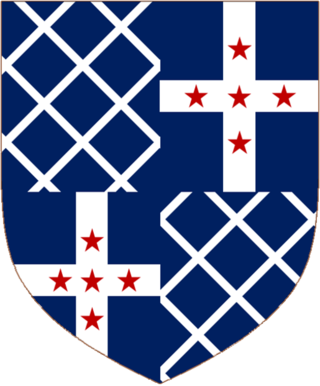
Baron Braye, of Eaton Bray in the County of Bedford, is a title in the Peerage of England. It was created in 1529 for Edmund Braye, 1st Baron Braye. However, the family originally originate from Normandy, they are direct descendants of Chevalier Baudry de Bray who came over to England in the Battle of Hastings of 1066. The family's local area in Leicestershire played host to two battles in England of note, the Battle of Bosworth Field where the current family's ancestor's were on opposing sides, and also Battle of Naseby during the First English Civil War, where the old manor house hosted King Charles I. The barony was created by writ, which means that it can descend through both male and female lines. He was succeeded by his son, the second Baron. He died from wounds received at the Battle of St Quentin in 1557. Lord Braye was childless and on his death the title fell into abeyance between his sisters.

Bunratty Castle is a large 15th-century tower house in County Clare, Ireland. It is located in the centre of Bunratty village, by the N18 road between Limerick and Ennis, near Shannon Town and its airport. The castle and the adjoining folk park are run by Shannon Heritage as tourist attractions.

Ashford Castle is a medieval and Victorian castle that has been expanded over the centuries and turned into a five star luxury hotel. It is near Cong on the County Mayo–Galway border, on the County Galway side of Lough Corrib, in Ireland. It is a member of the Red Carnation Hotels organisation and was previously owned by the Guinness family.
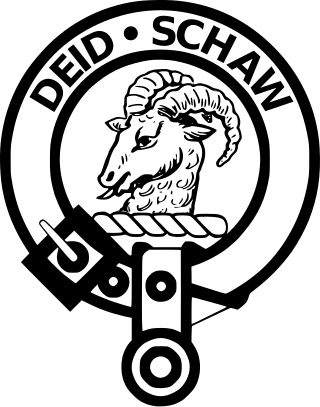
The Clan Ruthven is a Lowland Scottish clan.

Newport is a town in County Tipperary in Ireland. It is in the barony of Owney and Arra. At the 2022 census the population was 2,183.
Robert Otway-Cave, styled The Honourable from 1839, was an Irish aristocrat and British politician.

Walter de Lacy was lord of Meath in Ireland. He was also a substantial land owner in Weobley, Herefordshire, in Ludlow, Shropshire, in Ewyas Lacy in the Welsh Marches, and several lands in Normandy. He was the eldest son of Hugh de Lacy, a leading Cambro-Norman baron in the Norman invasion of Ireland, and Rohese of Monmouth.
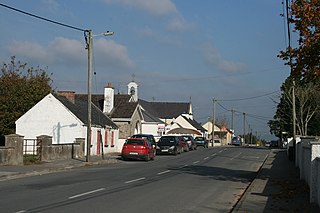
Gortnahoe, also known as Gortnahoo, is a village in County Tipperary, Ireland. It is located on the R689 regional road 6 km (3.7 mi) south of Urlingford, County Kilkenny. It is 3 km (1.9 mi) southeast of the N8 Dublin - Cork road. Gortnahoe, pronounced "Gurt/na/hoo" by the locals, is part of the parish of Gortnahoe–Glengoole.

Theobald Walter was the first Chief Butler of Ireland. He also held the office of Chief Butler of England and was the High Sheriff of Lancashire for 1194. Theobald was the first to use the surname Butler of the Butler family of Ireland. He was involved in the Irish campaigns of King Henry II of England and John of England. His eldest brother Hubert Walter became the Archbishop of Canterbury and justiciar and Lord Chancellor of England.
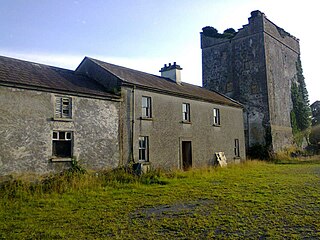
Monivea Castle is a former O'Kelly tower house, located near Monivea in County Galway, Ireland. It was acquired by the ffrench family, one of the fourteen Tribes of Galway, who developed it further, enhancing the lands and building the Monivea Castle—all increasing the fortification around the original Norman tower.
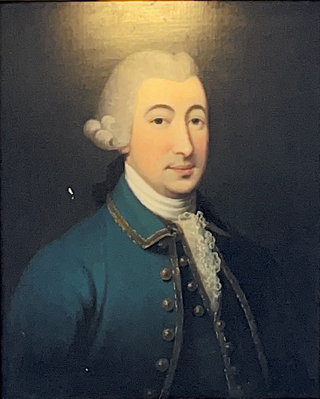
Peter Browne, 2nd Earl of Altamont was an Anglo-Irish landowner, absentee slaveholder and MP.

Richard Óg de Burgh, 2nd Earl of Ulster and 3rd Baron of Connaught, called The Red Earl, was one of the most powerful Irish nobles of the late 13th and early 14th centuries and father of Elizabeth, wife of King Robert the Bruce of Scotland.
The High Sheriff of Leitrim was the British Crown's judicial representative in County Leitrim, Ireland from c.1582 until 1922, when the office was abolished in the new Free State and replaced by the office of Leitrim County Sheriff. The sheriff had judicial, electoral, ceremonial and administrative functions and executed High Court Writs. In 1908, an Order in Council made the Lord-Lieutenant the Sovereign's prime representative in a county and reduced the High Sheriff's precedence. However the sheriff retained his responsibilities for the preservation of law and order in the county. The usual procedure for appointing the sheriff from 1660 onwards was that three persons were nominated at the beginning of each year from the county and the Lord Lieutenant then appointed his choice as High Sheriff for the remainder of the year. Often the other nominees were appointed as under-sheriffs. Sometimes a sheriff did not fulfil his entire term through death or other event and another sheriff was then appointed for the remainder of the year. The dates given hereunder are the dates of appointment. All addresses are in County Leitrim unless stated otherwise.
Robert de Holywood was an Irish judge and landowner who held the office of Chief Baron of the Irish Exchequer. He was the ancestor of the Holywood family of Artane Castle, and of the St. Lawrence family, Earls of Howth. He was a substantial landowner with property in Dublin, Meath and Louth. He became extremely unpopular, and was removed from office after numerous complaints of "oppression and extortion" were made against him. These were apparently inspired ĺargely by his close association in the mid-1370s with Sir William de Windsor, the embattled Lord Lieutenant of Ireland.

Parkstown is a townland in County Tipperary in Ireland. Occupying 624 acres, it is located in the civil parish of Ballymoreen in the barony of Eliogarty in the poor law union of Thurles.

Ennistymon House, sometimes known as Ennistimon House, is a former country house in the village of Ennistymon, County Clare in Ireland. Built on the elevated site of a medieval castle, the 18th century house is now in use as a hotel. The hotel, the Falls Hotel, is owned by members of the McCarthy family.
Annette Jocelyn Otway-Ruthven was an Irish historian specialising in medieval Irish history, and was among the earliest female academics appointed in Trinity College Dublin.
Sarah Otway-Cave, 3rd Baroness Braye was an English noblewoman. The title of Baron Braye, originally created in 1529 for her ancestor Edmund Braye, 1st Baron Braye and abeyant since the death of the second baron in 1557, was called out of abeyance in her favor in 1839.
Frances Emilia Crofton née Dunn, known professionally as Mrs William Crofton, was an Anglo-Irish landscape painter of the picturesque style who flourished in the mid-19th century. In 1854 she published Eight Views, a folio edition of lithograph prints of her original landscape paintings of Britain and Ireland, to be sold for charitable purposes. These sets of eight prints were purchased by various bishops, members of the aristocracy and others, and some are now in public collections. She married Anglo-Irish landowner William Crofton, a naval surgeon and justice of the peace, and lived for the rest of her life in Cheltenham, Gloucestershire and at Lakefield, a mansion with a large estate in County Leitrim, Ireland.














